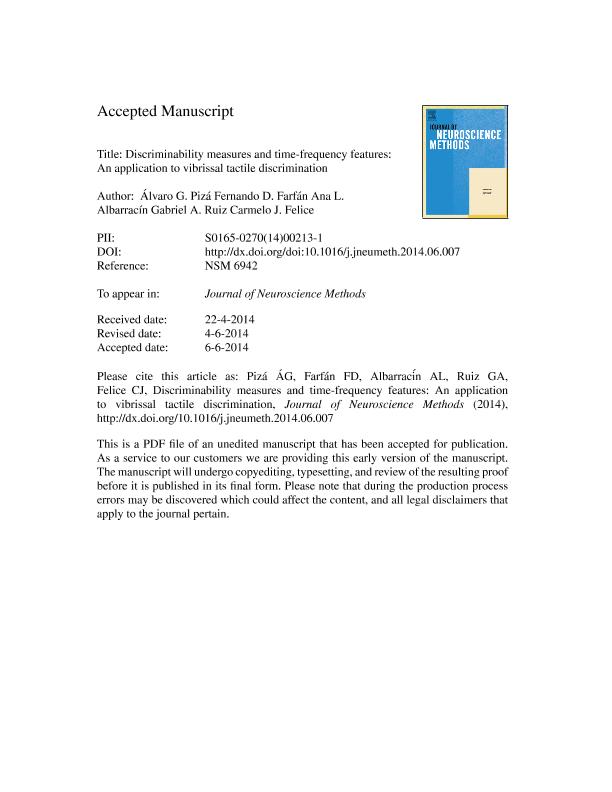Artículo
Discriminability measures and time-frequency features: an application to vibrissal tactile discrimination
Pizá, Alvaro Gabriel ; Farfan, Fernando Daniel
; Farfan, Fernando Daniel ; Albarracin, Ana Lia
; Albarracin, Ana Lia ; Ruiz, Gabriel Alfredo; Felice, Carmelo Jose
; Ruiz, Gabriel Alfredo; Felice, Carmelo Jose
 ; Farfan, Fernando Daniel
; Farfan, Fernando Daniel ; Albarracin, Ana Lia
; Albarracin, Ana Lia ; Ruiz, Gabriel Alfredo; Felice, Carmelo Jose
; Ruiz, Gabriel Alfredo; Felice, Carmelo Jose
Fecha de publicación:
06/2014
Editorial:
Elsevier Science
Revista:
Journal of Neuroscience Methods
ISSN:
0165-0270
Idioma:
Inglés
Tipo de recurso:
Artículo publicado
Clasificación temática:
Resumen
Background: Often, the first problem that the neuroscientist must face is to determine if a specific stimulus set applied to biological system produces specific, precise and well differentiated responses. New method: In the present study we have proposed four discriminability measures to evaluate the feasibility of differentiating experimental conditions: information measures based on information theory, percentage overlap based on Linacre method, Bhattacharyya distance and univariate standard distance. All discriminability measures were evaluated on experimental protocols related to vibrissal tactile discrimination. Results: Time–frequency features were extracted from afferent discharges and then, pairwise comparisons were realized by using the proposed discriminability measures. Our results reveal the existence of time–frequency patterns which allows differentiating of sweep conditions from multifiber recordings. Comparison with existing methods: Currently, statistical methods used to justify significant differences in experimental conditions have rigorous criteria that must be met for correct validation of results. Discriminability measures proposed here are robust and can be adjusted to different experimental conditions (time series, repeated measures, specific variables and other). Conclusions: Discriminability measures allowed determining the time intervals where two sweep situations have the highest probability to be differentiated from each other. High discriminability percentages were observed into protraction phase, although to a lesser degree, it was also observed in retraction phase. It was demonstrated that sensibility of discriminability measures are different. This revealing a greater ability to highlight percentage changes of pairwise comparisons. Finally, the methods here proposed can be adapted to other features of biological responses.
Archivos asociados
Licencia
Identificadores
Colecciones
Articulos(INSIBIO)
Articulos de INST.SUP.DE INVEST.BIOLOGICAS
Articulos de INST.SUP.DE INVEST.BIOLOGICAS
Citación
Pizá, Alvaro Gabriel; Farfan, Fernando Daniel; Albarracin, Ana Lia; Ruiz, Gabriel Alfredo; Felice, Carmelo Jose; Discriminability measures and time-frequency features: an application to vibrissal tactile discrimination; Elsevier Science; Journal of Neuroscience Methods; 233; 6-2014; 78-88
Compartir
Altmétricas



